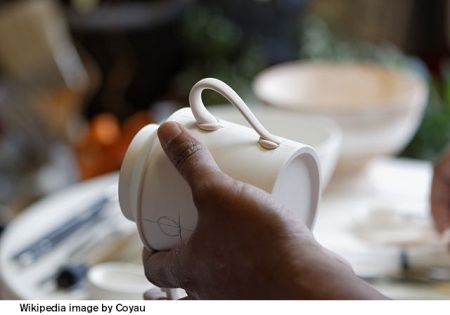Post 638 –by Gautam Shah
.
Many materials, even if suitable for their engineering performance do not have an appropriate surface system, nor are they amenable to modifications towards such needs. Large number of objects that we use to day have applied surface systems. Applied surface systems consist of foreign materials, generically, either of same type, or of different constitution.

There are many methods of applying surface systems to base objects. Some surface systems stay in place due to gravity, whereas others may require some degree of fastening, achieved by mechanical fixing, adhesion, chemical reaction, ion attraction, etc. Many surface system use combination fixing, i.e. one method to achieve initial anchorage, and another for ultimate fixing. In some instances one system of fixing is operative for normal circumstances, and another one is provisioned for extra ordinary stress conditions.

Fixing of a surface system: Fixing makes the applied surface system operate in consonance with the entity. The space between the surface system and the entity is reduced or eliminated by very close packing, or by introducing an intermediary element. Adhered surface system, cover the object interactively. Adhered surface systems nearly merge with the base entity, and as a result the transfer of stresses is evenly distributed. Adhesives do not form localized stress points like screws and nuts do. For this reason adhered surface systems could be much thinner, than the body necessary for mechanical fixing. A thin body surface system has greater flexibility, ductility, and stretchability, and so better unified behaviour with the base entity.

Adhesives can join substances that are materially and dimensionally different and form-wise very difficult. Adhesive joints may be designed as required, to be elastic or rigid. Relatively low process temperature involved in adhesive bonding does not affect the crystallographic structure of the metal. Adhesives can create very extensive, multi layered laminar compositions without physically cutting or puncturing the materials.

Limitations of adhesives are few but important. Adhesives require elaborate surface treatments, specific application conditions, curing procedures and considerable expense of time for setting. Inspection of the joint is difficult. Joint design becomes very critical compared with other mechanical and thermal processes. The adhesive itself may corrode the materials it is joining, or induce stresses during curing.
- A very strong adhesive will not allow a joint to open out, so there is a rupture elsewhere in the material.
- Too weak an adhesive fails and separates into two distinct layers.
- An adhesive may fail to adhere to one face.

With correctly prepared surfaces, the adhesion at the interface is usually greater than the strength of the adhesive itself, and failures occur within the adhesive film. Failure of the adhesive film is usually caused by the propagation of cracks accelerated by the presence of discontinuities and flaws. Therefore, thin layered adhesives provide the strongest joints. Usually the adhesive selected should have similar strength characteristics to be adherends being bonded together. An exception would be where boding is only temporary pending another joining processes to be used. Most adhesives show optimum strength characteristics when in tension or compression closely followed by, shear. Often the high strength, thermosetting adhesives form brittle bonds that are adversely affected by vibration and impact loading, causing the bond to crack or shatter. Under such conditions a slightly weaker but more resilient adhesives may perform more satisfactorily. Adhesives may show a satisfactory strength characteristic under test conditions, but will tend to creep under sustained loads in service.

Adhered finishes often require an intermediary agent, the adherent, to achieve the bonding. The adherents have a dual or multilateral qualities, capable of adhering to the singular or multiple components of both, the surface system and the base entity. The adhesion is provided by surface tension, ionic attraction, friction and chemical bonding. Adhered finishes are occasionally removable but not easily demountable and relocatable. Adhered finishes also have size limitations. The joints in adhered, finishes occur as a thin divide between the two surface components, or as lap-over with a seam joint (stitched, folded, fused).
Adhered finishes, due to their simplistic technology can be employed on remote locations. The surface components are sometimes designed to have different personalities on the outside and the face to be attached to the base.

Adhesives are used for joining a wide variety of similar and dissimilar materials such as: paper, wood, leather, glass, fabrics, ceramics, plastics, rubbers and metals. However, the largest sectors for adhesives are masonry structures, where large variety of cementing materials like, clays, Portland cement, lime, plaster of Paris (gypsum plasters), etc. are used. Another field akin to adhesives is of sealants, putties, mastic compounds, waterproofing agents, noise dampening coatings. Structural adhesives are expected to provide structural properties equal or often better than the materials being joined. Adhesives perform many other functions. Silicone and polysulfide rubber are used for dampening vibration (glass to window frames). Aircraft and automobile frame components are bonded by adhesives to save labour, weight, and expense of rivets like fasteners. Components joined with an adhesive cannot be separated but some demountable adhesives are available.


.
Other Blogs on related topics
TYPES of ADHESIVES
https://interiordesignassist.wordpress.com/2015/06/14/types-of-adhesives/
ADHESIVES – Bonding
https://interiordesignassist.wordpress.com/2014/11/13/adhesives-bonding/
NATURAL ADHESIVES (Bio-adhesives)
https://interiordesignassist.wordpress.com/2014/10/25/natural-adhesives-bio-adhesives/
ADHESIVES
https://interiordesignassist.wordpress.com/2014/10/19/adhesives/
MASTIC, PUTTIES and CAULKING COMPOUNDS
https://interiordesignassist.wordpress.com/2014/11/01/mastic-putties-and-caulking-compounds/
.
Pingback: SURFACE MODIFICATIONS | Interior Design Assist